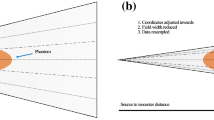Abstract
The effect of couch sag on treatment delivery accuracy has been investigated by modelling the variation of delivered dose from planned dose due to the difference between the treatment and simulation couches. The couch sag of the Siemens (Concord, USA) Primus linac was determined relative to the couch sag of the Siemens (Germany) Sensation 4 CT Scanner. A phantom planning study was then undertaken to evaluate the likely clinical impact of the couch sag through an evaluation of changes in dose distribution, dose volume histograms and monitor units. The couch sag was simulated by altering the angle of the CT gantry when obtaining image studysets. A second investigation into the effects of couch sag was undertaken using an existing patient CT studyset. For this investigation, the couch sag was simulated by appropriate rotation of the gantry and collimator angles. The effect of couch sag on calculated monitor units (MU) was found to be statistically insignificant. The small monitor unit changes observed were likely to result from differences in the average linear attenuation coefficient along the beam path to the isocentre. The major differences seen however were in the regions away from the central axis. The dose volume histograms showed that both the bladder and rectum were further spared with increasing tilt angle whilst the PTV dose was unchanged. The only issue at South West Sydney Cancer Services (SWSCS) in terms of patient position variation arises from the angle induced by the couch sag (or more precisely, the difference in couch sag angle between the CT and Linac couches). Due to the relatively uniform structures (of PTV, bladder and rectum), and the proximity of these critical structures to the isocentre, this angular rotation about the isocentre did not cause any major variations to the DVH, MU and isodoses for realistic levels of couch sag (i.e. less than 20mm).
Similar content being viewed by others
References
Malone, S., Szanto, J., Perry, G.et al., A prospective comparison of three systems of patient immobilization for prostate radiotherapy, Int J Radiat Oncol Biol Phys, 48: 657–65, 2000.
International Electrotechnical Commission,International Standard IEC 976, Section 14.4, page 89, CEI/IEC 976, 1989.
Australasian College of Physical Scientists and Engineers in Medicine (ACPSEM) [Millar, M., Cramb, J., Das, R., Ackerly, T., Brown, G., Webb, D.],Position Paper: Recommendations for the safe use of external beams and sealed brachytherapy sources in radiation oncology, Aust Phys. Eng. Sci Med. 20(3) (Supp): p24, 1997.
Court, L., Rosen, I., et al., Evaluation of mechanical precision and alignment uncertainties for an integrated CT/LINAC system, Med Phys 30(6): 1198–210, 2003.
Skala, M., Berry, M., Duchesne, G., Gogna, K., Tai, K-H., Turner, S., Kneebone, A., Rolfo, A. andHaworth, A. Australian and New Zealand three-dimensional conformal radiation therapy consensus guidelines for prostate cancer, Australasian Radiology, 48, 493–501, 2004.
Author information
Authors and Affiliations
Corresponding author
Rights and permissions
About this article
Cite this article
Arts, J.K., Bailey, M.J., Bannister, K. et al. Investigation into the impact of couch sag on delivered dose. Australas. Phys. Eng. Sci. Med. 29, 241–250 (2006). https://doi.org/10.1007/BF03178572
Received:
Accepted:
Issue Date:
DOI: https://doi.org/10.1007/BF03178572




